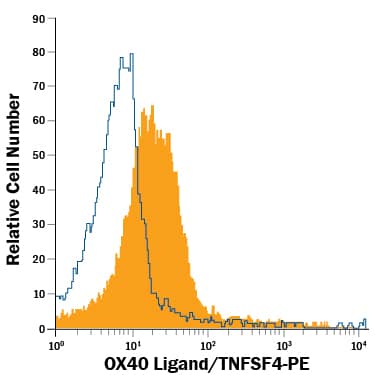Mouse OX40 Ligand/TNFSF4 PE-conjugated Antibody
R&D Systems, part of Bio-Techne | Catalog # FAB1236P


Key Product Details
Validated by
Species Reactivity
Applications
Label
Antibody Source
Product Specifications
Immunogen
Gln49-Leu198
Accession # P43488
Specificity
Clonality
Host
Isotype
Scientific Data Images for Mouse OX40 Ligand/TNFSF4 PE-conjugated Antibody
Detection of OX40 Ligand/TNFSF4 in Activated Mouse Splenocytes by Flow Cytometry.
Mouse splenocytes were treated with LPS and recombinant mouse GM-CSF (Catalog # 415-ML), then stained with Goat Anti-Mouse OX40 Ligand/TNFSF4 PE-conjugated Antigen Affinity-purified Polyclonal Antibody (Catalog # FAB1236P, filled histogram) or isotype control antibody (Catalog # IC108P, open histogram). View our protocol for Staining Membrane-associated Proteins.Applications for Mouse OX40 Ligand/TNFSF4 PE-conjugated Antibody
Flow Cytometry
Sample: Mouse splenocytes treated with LPS and recombinant mouse GM-CSF
Formulation, Preparation, and Storage
Purification
Formulation
Shipping
Stability & Storage
Background: OX40 Ligand/TNFSF4
OX40 Ligand (OX40L), also known as gp34, is a type II transmembrane glycoprotein belonging to the TNF superfamily. Murine OX40L cDNA encodes a 198 amino acid (aa) residue protein comprised of a 28 aa N-terminal cytoplasmic domain, a 20 aa transmembrane segment, and a 150 aa C-terminal extracellular domain (1). Human and murine OX40L share 46% sequence identity at the amino acid level (1). The OX40L is expressed on activated antigen presenting cells such as B cells, macrophages, dendritic cells, and on endothelial cells at the site of inflammation. The receptor for OX40L is OX40 (CD134) that is expressed predominantly on activated CD4+ T cells. Expression of OX40 is transient following engagement of T cell receptors (2). Ligation of OX40L by OX40 stimulates proliferation and differentiation of activated B cells, and increases immunoglobulin secretion (3, 4). The expression of OX40L on B cells is up-regulated by CD40 ligation (3). Engagement of the OX40-OX40L system has co-stimulatory effects on T cells by stimulating the production of cytokines by T helper cells and increasing the survival of memory T cells (2, 5). Blocking of the OX40-OX40L interaction in vitro inhibits co-stimulation resulting in decreased T cell proliferation and adhesion of T cells to endothelial cells. Inhibition of the OX40-OX40L interaction in disease models has beneficial effects in acute graft-versus-host disease, inflammatory bowel disease, and decreases the development of collagen-induced arthritis and experimental leishmaniasis (6).
References
- Baum, P.R. et al. (1994) EMBO J. 13:3992.
- Gramaglia, I. et al. (1999) J. Immunol. 161:6510.
- Stuber, E. et al. (1995) Immunity 2:507.
- Malstrom, V. et al. (2001) J. Immunol. 166:6972.
- Maxwell, J.R. et al. (2000) J. Immunol. 164:107.
- Weinberg, A.D. (2002) Trends Immunol. 23:102.
Alternate Names
Gene Symbol
UniProt
Additional OX40 Ligand/TNFSF4 Products
Product Documents for Mouse OX40 Ligand/TNFSF4 PE-conjugated Antibody
Product Specific Notices for Mouse OX40 Ligand/TNFSF4 PE-conjugated Antibody
For research use only